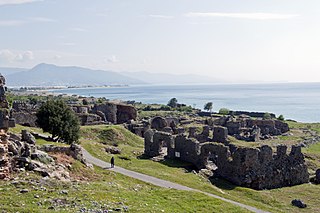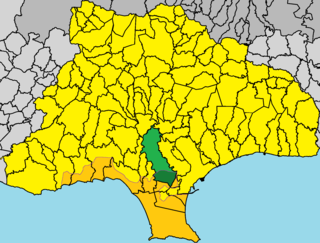
Paphos is a coastal city in southwest Cyprus and the capital of Paphos District. In classical antiquity, two locations were called Paphos: Old Paphos, today known as Kouklia, and New Paphos.

The archaeology of Israel is the study of the archaeology of the present-day Israel, stretching from prehistory through three millennia of documented history. The ancient Land of Israel was a geographical bridge between the political and cultural centers of Mesopotamia and Egypt.

Akrotiri and Dhekelia, officially the Sovereign Base Areas of Akrotiri and Dhekelia (SBA), is a British Overseas Territory on the island of Cyprus. The areas, which include British military bases and installations formerly part of the Crown colony of Cyprus, were retained by the British under the 1960 treaty of independence signed by the United Kingdom, Greece, Turkey and representatives from the Greek and Turkish Cypriot communities. The territory serves an important role as a station for signals intelligence and provides a vital strategic part of the United Kingdom surveillance-gathering network in the Mediterranean and the Middle East.

Episkopi Bay is a bay west of the Akrotiri Peninsula on the south-western shore of Cyprus, between Paphos and Akrotiri. On the other side of the Akrotiri Peninsula is Akrotiri Bay. It is famous for its beaches and fish restaurants. Despite the Turkish invasion and ensuing ethnic division of Cyprus in 1974, a number of Turkish Cypriots chose to remain in the area.

Kourion was an important ancient Greek city-state on the southwestern coast of Cyprus. In the twelfth century BCE, after the collapse of the Mycenaean palaces, Greek settlers from Argos arrived on this site.
Akrotiri means "cape, promontory". As a result, many different seaside places bear this name. Akrotiri may refer to:

The Cypro-Minoan syllabary (CM), more commonly called the Cypro-Minoan Script, is an undeciphered syllabary used on the island of Cyprus and at its trading partners during the late Bronze Age and early Iron Age. The term "Cypro-Minoan" was coined by Arthur Evans in 1909 based on its visual similarity to Linear A on Minoan Crete, from which CM is thought to be derived. Approximately 250 objects—such as clay balls, cylinders, and tablets and votive stands—which bear Cypro-Minoan inscriptions, have been found. Discoveries have been made at various sites around Cyprus, as well as in the ancient city of Ugarit on the Syrian coast.

Cape Zevgari, lies within Akrotiri and Dhekelia, a British Overseas Territory on the island of Cyprus, administered as a Sovereign Base Area. It is located in the Western Sovereign Base Area and forms the south-west point of the Akrotiri Peninsula which is the most southerly part of the island. The cape forms the southern end of Episkopi Bay.

Anemurium, also called Animurium, is an ancient city whose ruins, now called Eski Anamur or Anemuryum, are close to the modern Turkish city of Anamur. It was in the Roman province of Cilicia, later Isauria, and was situated near a high promontory that marks the southernmost point of Asia Minor, only 64 km from Cyprus. In the Middle Ages, it was called Stallimur.

Hala Sultan Tekke or the Mosque of Umm Haram is a mosque and tekke complex on the west bank of Larnaca Salt Lake, in Larnaca, Cyprus. Umm Haram was the wife of Ubada bin al-Samit, a companion of the Islamic prophet Muhammad, and foster sister of Muhammad's mother, Aminah bint Wahb.

Limassol Salt Lake is the largest inland body of water on the island of Cyprus, in Akrotiri and Dhekelia.

Akrotiri is the site of a Cycladic Bronze Age settlement on the volcanic Greek island of Santorini (Thera). The name comes from the nearby village of Akrotiri.

Ypsonas is a municipality in the Limassol prefecture of Cyprus. It is one of the largest villages in the Limassol District of Cyprus and is located about 7 kilometers west of Limassol city. The southern part of the village is within the administrative borders of the British military base of Akrotiri - Episkopi. It has 10,916 residents as recorded in the Census of 2011.

Agios Sozomenos is a deserted village in the Nicosia District of Cyprus, close to the Green Line and near Potamia. It is located at the confluence of the Alikos river with the Gialias, the second-longest river of Cyprus.
Katalymata ton Plakoton is an archeological site in the vicinity of Akrotiri, on the island of Cyprus.

Limassol District or Lemesos is one of the six districts of Cyprus. As of 2011, it had a population of 239,842, 77% of which was urban. Its main city is Limassol. Part of the British Overseas Territory of Akrotiri and Dhekelia forms an enclave on the Akrotiri Peninsula, under the sovereignty of the United Kingdom.

Konya Archaeological Museum is a state archaeological museum in Konya, Turkey. Established in 1901, it had been relocated twice before moving to its present location in 1962. One of the most prominent displays in the museum is of sarcophagi and other antiquities from the ancient city of Çatalhöyük. Other exhibits relate to the Neolithic, Bronze Age, Iron Age, Classical, Hellenistic, Roman and the Byzantine periods; artifacts consist of ceramic ware, stone and bronze wares, ornaments and inscriptions. Among the objects displayed is a marble sarcophagus of the 3rd century AD, with elaborate relief sculptures depicting the life of Hercules. In the outer open yard of the museum there are a number of small sculptures, sarcophagi, column capitals, and samples of epigraphy.
Vassos Karageorghis FBA was a Cypriot archaeologist and director of the Department of Antiquities, Cyprus.
The archaeology of Cyprus involves the analysis of human activity derived from Cypriot artefacts and architecture from the Neolithic through to the British period. The earliest archaeological discoveries in Cyprus are attributed to European amateur collectors or “treasure hunters” during the early 19th century. By the mid 19th century, systematic fieldwork and excavations were conducted on various sites involving studying the remains of Cypriot cemeteries and tombs, maritime artefacts, architecture, pottery as well as a range of other individual artefacts. Subsequent findings and analysis detail the social and physical landscapes of ancient Cyprus as well as their evolving culture, religious beliefs and technology throughout antiquity.

Dreamer's Bay is an ancient port complex located on the southern tip of the Akrotiri Peninsula on Cyprus. The remains have been dated to the Roman or Byzantine period in history and included the port, associated warehouses, quarries and a ship repair yard. The site was believed to have been in existence from the 5th to 6th centuries AD. The site was most likely a waypoint for resupply for ships transiting around the Mediterranean Sea between Greece, Egypt, Syria and Turkey.
















